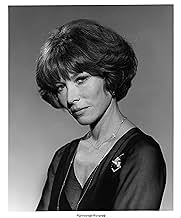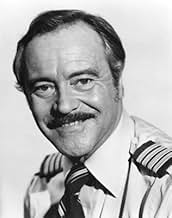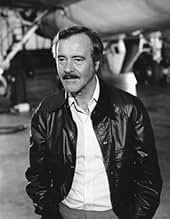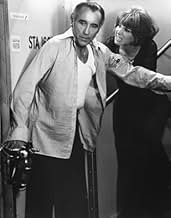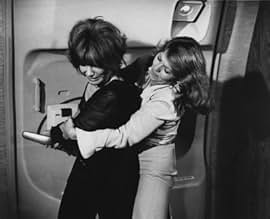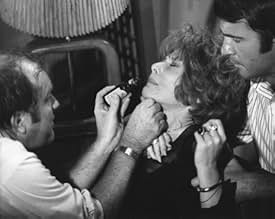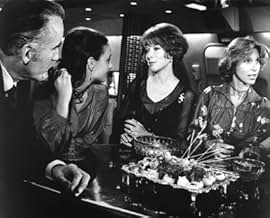NOTE IMDb
5,8/10
13 k
MA NOTE
Des voleurs d'art ayant détournés un 747, se heurtent au brouillard et s'écrasent dans l'océan. Ils se retrouvent alors emprisonnés avec les passagers à trente mètres sous la mer.Des voleurs d'art ayant détournés un 747, se heurtent au brouillard et s'écrasent dans l'océan. Ils se retrouvent alors emprisonnés avec les passagers à trente mètres sous la mer.Des voleurs d'art ayant détournés un 747, se heurtent au brouillard et s'écrasent dans l'océan. Ils se retrouvent alors emprisonnés avec les passagers à trente mètres sous la mer.
- Réalisation
- Scénario
- Casting principal
- Nommé pour 2 Oscars
- 2 nominations au total
Avis à la une
Of all the disaster flicks, this seems to be the one I enjoy most, perhaps it was the first one I would see.
But looking back at the hot pants in Poseidon Adventure & Dunaway's dress and the tuxedoes in Towering Inferno, Airport '77 is quite an elegantly dressed cast, aren't they?
The movie would get famed Hollywood fashion expert Edith Head to dress the cast and it shows. Anyone else would have made Brenda Vaccarro look obese trying to put her in that pullover sweater.
Airplane! would make fun of Edith Head being credited for '77 like that, by crediting their own costumer, but 27 years later, the wardrobe makes the cast of '77 appear tremendously dashing, giving the tragedy that greater a feel as well.
Jack Lemmon was an incredible standout as the hero of the piece, in comparison to Paul Newman's sexism in Towering Inferno (he never speaks to Jennifer Jones as a human during their entire ordeal with the children) or Heston's stiffness or McQueen's inexpressiveness.
Two years after her Oscar nomination, Vaccarro was hardly the disaster flicks idea of a leading lady as well, so she is quite a one-of-a-kind casting also.
When I was little, I was most fascinated with Arlene Golonka, who I knew from the Andy Griffith show.
Later, identifying the rest of the cast just made it more and more fun. Dracula, Buck Rogers, Kolchak the Nightstalker (Darren McGavin & Jack Lemmon were a powerhouse duo).
Then the names and stars figured into it. DeHavilland, Cotten, Grant. No one looked more out of place than Olivia DeHavilland in an underwater airplane.
Robert Hooks as the crippled bartender and Tom Sullivan (who is actually blind) as the pianist added even more flavor.
There is M. Emmet Walsh, "The Name, But What Which One Is Him?" actor. He is the doctor, and I do enjoy his one scene when he explains who he really is.
Monica Lewis, disaster movie staple. She would appear in Earthquake and Concorde: Airport '79. Check out her expression as she and Olivia DeHavilland enter the lifeboat. It reads "Miss DeHavilland, I'm one of your biggest fans. I really enjoyed you in Gone With The Wind." Lucy Ricardo lives.
Should it have been a commercial airline, instead of a private plane? Not necessarily.
I enjoy watching it now and observing a few of the female extras at the beginning of the crash don't seem to be present anymore by the end. It seems that they weren't available for filming then.
I would argue, as a movie, that this one is more fun to watch than the first one. Lancaster and Seberg in the first Airport movie are comical to me trying to be so serious.
And the second Airport movie, Airport '75, is funnier than Airplane.
There is a very strong and different feel from Airport '77 than the other Airport flicks or the other disaster films in general.
But looking back at the hot pants in Poseidon Adventure & Dunaway's dress and the tuxedoes in Towering Inferno, Airport '77 is quite an elegantly dressed cast, aren't they?
The movie would get famed Hollywood fashion expert Edith Head to dress the cast and it shows. Anyone else would have made Brenda Vaccarro look obese trying to put her in that pullover sweater.
Airplane! would make fun of Edith Head being credited for '77 like that, by crediting their own costumer, but 27 years later, the wardrobe makes the cast of '77 appear tremendously dashing, giving the tragedy that greater a feel as well.
Jack Lemmon was an incredible standout as the hero of the piece, in comparison to Paul Newman's sexism in Towering Inferno (he never speaks to Jennifer Jones as a human during their entire ordeal with the children) or Heston's stiffness or McQueen's inexpressiveness.
Two years after her Oscar nomination, Vaccarro was hardly the disaster flicks idea of a leading lady as well, so she is quite a one-of-a-kind casting also.
When I was little, I was most fascinated with Arlene Golonka, who I knew from the Andy Griffith show.
Later, identifying the rest of the cast just made it more and more fun. Dracula, Buck Rogers, Kolchak the Nightstalker (Darren McGavin & Jack Lemmon were a powerhouse duo).
Then the names and stars figured into it. DeHavilland, Cotten, Grant. No one looked more out of place than Olivia DeHavilland in an underwater airplane.
Robert Hooks as the crippled bartender and Tom Sullivan (who is actually blind) as the pianist added even more flavor.
There is M. Emmet Walsh, "The Name, But What Which One Is Him?" actor. He is the doctor, and I do enjoy his one scene when he explains who he really is.
Monica Lewis, disaster movie staple. She would appear in Earthquake and Concorde: Airport '79. Check out her expression as she and Olivia DeHavilland enter the lifeboat. It reads "Miss DeHavilland, I'm one of your biggest fans. I really enjoyed you in Gone With The Wind." Lucy Ricardo lives.
Should it have been a commercial airline, instead of a private plane? Not necessarily.
I enjoy watching it now and observing a few of the female extras at the beginning of the crash don't seem to be present anymore by the end. It seems that they weren't available for filming then.
I would argue, as a movie, that this one is more fun to watch than the first one. Lancaster and Seberg in the first Airport movie are comical to me trying to be so serious.
And the second Airport movie, Airport '75, is funnier than Airplane.
There is a very strong and different feel from Airport '77 than the other Airport flicks or the other disaster films in general.
I can't imagine anything thinking that "Airport '77" is a great movie. After all, it takes the usual "Airport" formula and throws it into a premise that is not only bizarre but rather silly. Yet, oddly, despite this, the movie IS enjoyable and worth seeing.
A rich guy has arranged for a private luxury 747 airliner to bring friends and loved ones to a big party. What no one realizes, however, is that several members of the crew are planning on using knockout gas to take control of the plane and then land it on some abandoned airport in the Bahamas. Apparently, it's all because they plan on stealing some paintings aboard the plane....though this seemed like silly motivation. I would have also considered ransoming off the passengers...which they aren't planning on doing.
Speaking of not planning....the overly complicated plan goes awry when the plane is flying under radar and accidentally collides with some beacon. IMDB says fog was responsible....I never noticed fog in this scene at all. Regardless, the plan crash lands in the ocean and soon sinks in what IMDB says is about 100 feet of water*. The cabin has managed to stay air tight....at least for now. But with air running out, is there any chance at rescue?
Despite a totally ludicrous premise, the film manages to make it all seem possible...which it surely isn't as you continue watching the story. Regardless, the story IS engaging and interesting. I did find it unusual that Jack Lemmon of all people plays a bit of an action hero! But still, it does manage to entertain and it sure kept me glued to the screen.
*Although they said the plane was a hundred feet down, this really could NOT have been the case, as the pilot swimming to the surface clearly would have been highly unlikely (that is a LONG way to free dive for someone untrained) and if he had survived, he likely would have been a physical mess as a result of decompression. Here, it all looked too easy to be that deep and the water clarity made it seem like the plane was about 50 feet down...from which a dive to the surface is much, much more likely to result in survival. I've made such dives to the surface myself....which isn't easy but is so much safer and easier than from 100 feet.
A rich guy has arranged for a private luxury 747 airliner to bring friends and loved ones to a big party. What no one realizes, however, is that several members of the crew are planning on using knockout gas to take control of the plane and then land it on some abandoned airport in the Bahamas. Apparently, it's all because they plan on stealing some paintings aboard the plane....though this seemed like silly motivation. I would have also considered ransoming off the passengers...which they aren't planning on doing.
Speaking of not planning....the overly complicated plan goes awry when the plane is flying under radar and accidentally collides with some beacon. IMDB says fog was responsible....I never noticed fog in this scene at all. Regardless, the plan crash lands in the ocean and soon sinks in what IMDB says is about 100 feet of water*. The cabin has managed to stay air tight....at least for now. But with air running out, is there any chance at rescue?
Despite a totally ludicrous premise, the film manages to make it all seem possible...which it surely isn't as you continue watching the story. Regardless, the story IS engaging and interesting. I did find it unusual that Jack Lemmon of all people plays a bit of an action hero! But still, it does manage to entertain and it sure kept me glued to the screen.
*Although they said the plane was a hundred feet down, this really could NOT have been the case, as the pilot swimming to the surface clearly would have been highly unlikely (that is a LONG way to free dive for someone untrained) and if he had survived, he likely would have been a physical mess as a result of decompression. Here, it all looked too easy to be that deep and the water clarity made it seem like the plane was about 50 feet down...from which a dive to the surface is much, much more likely to result in survival. I've made such dives to the surface myself....which isn't easy but is so much safer and easier than from 100 feet.
I was first exposed to this movie when it seemed to air on NBC every six months or so back in the early 80s, and as a result it's hindered my ability to enjoy it as a guilty pleasure on home video, even on widescreen DVD. That's because the TV showings were purposefully padded to two parts with more than an hour of extra footage that in this case places the characters in much better context than they appear in the theatrical version, (don't get me wrong, it doesn't elevate it to a topnotch story, but at least the narrative makes better sense). The biggest revelation upon seeing the theatrical cut was how all of George Kennedy's scenes before the crash weren't there any more.
Even at it's best, Airport 77 is only par for the course as far as disaster movies go. The plot is a little more innovative and the rescue scenes of trying to survive and then get the plane raised are more realistic than what we were served up in Airport 1975 with the stewardess flying the plane. Jack Lemmon does succeed as the nominal lead and that helps make one more charitable toward the rest of the supporting cast which is largely wasted in some classic, stereotyped cliched roles. But towards the end, it starts to drag just a bit. You can also see the beginnings of Jimmy Stewart's declining health since he's basically forced to play his part as though he were appearing as a guest on the Johnny Carson show instead of making his character more distinctive.
The widescreen DVD is worth having but I strongly recommend catching the expanded TV version instead, even if it is panned and scanned.
Even at it's best, Airport 77 is only par for the course as far as disaster movies go. The plot is a little more innovative and the rescue scenes of trying to survive and then get the plane raised are more realistic than what we were served up in Airport 1975 with the stewardess flying the plane. Jack Lemmon does succeed as the nominal lead and that helps make one more charitable toward the rest of the supporting cast which is largely wasted in some classic, stereotyped cliched roles. But towards the end, it starts to drag just a bit. You can also see the beginnings of Jimmy Stewart's declining health since he's basically forced to play his part as though he were appearing as a guest on the Johnny Carson show instead of making his character more distinctive.
The widescreen DVD is worth having but I strongly recommend catching the expanded TV version instead, even if it is panned and scanned.
So a plane crashes into the sea and we are about to witness the sheer rescue capabilities of the navy or spoken in a disaster movie term: human rescue capabilities.
The movie is based on a famous book by Royal Air Force pilot Arthur Hailey. I don't know about the book but the movie is based around polar opposites. Human vs nature is the true core of this film. The characters are/have always polar opposites. Rich and poor, altruism and egoism, young and old. The movie becomes enriched through the play of these different polarities. Iconic actors give the movie the class that it needs.
There is one more thing the movie creates. The romantic thought of safety through a certain kind of authority. It is the same romantic thought some have with German cars or the police as your friend and helper. Of course these thoughts are far from reality because there are thousands of people dying in the ocean around the globe. I speak of refugees that not get rescued by maritime service branches around the world. Even though I definitely doubt that if someone not as rich would be rescued like that. Nevertheless the movie, as smart as it is, shows the possibilities we had then (imagine what we could do today) and I think humans can do unimaginable things if we stick together and I like the thought I get from this movie: someday we might.
They don't make movies like that anymore. If military branches are shown today, they always fight. In todays disaster movies people need to help themselves or getting rescued by super heroes.
The movie is based on a famous book by Royal Air Force pilot Arthur Hailey. I don't know about the book but the movie is based around polar opposites. Human vs nature is the true core of this film. The characters are/have always polar opposites. Rich and poor, altruism and egoism, young and old. The movie becomes enriched through the play of these different polarities. Iconic actors give the movie the class that it needs.
There is one more thing the movie creates. The romantic thought of safety through a certain kind of authority. It is the same romantic thought some have with German cars or the police as your friend and helper. Of course these thoughts are far from reality because there are thousands of people dying in the ocean around the globe. I speak of refugees that not get rescued by maritime service branches around the world. Even though I definitely doubt that if someone not as rich would be rescued like that. Nevertheless the movie, as smart as it is, shows the possibilities we had then (imagine what we could do today) and I think humans can do unimaginable things if we stick together and I like the thought I get from this movie: someday we might.
They don't make movies like that anymore. If military branches are shown today, they always fight. In todays disaster movies people need to help themselves or getting rescued by super heroes.
Following the not-so-spectacular "Airport 1975" comes "Airport '77" which is a welcome addition to the Disaster Movie genre. In typical "Airport" fashion, a routine plane ride, this time carrying various celebrities and other high-profile people, gets into some trouble when it crashes into the ocean in the middle of the Bermuda Triangle....
Though the decor of the flash plane filled with VIP's is dreary compared to the fabulous colours of the chairs in "Airport 1975", the characters are a major improvement, along with the actual danger that the passengers and crew are placed in.
In typical Disaster Movie style, the cast is large, and many of them are forgettable, however, stand-out performances in "Airport '77" include Jack Lemmon in a serious role as the likable Captain Gallagher, Lee Grant is Karen Wallace a VIP guest of the nasty variety, the underrated Pamela Bellwood as a young mother, the lovely Kathleen Quinlann is as usual outstanding, but unfortunately under-used here, but the stand-out star of the film is of course Brenda Vaccaro as Captain Gallagher's girlfriend Even Clayton. Vaccaro is certainly one of the better leading ladies in a Disaster Movie, but is also a surprising choice. Nevertheless, she is fantastic, it is a shame she is not more recognized for her work.
Overall, "Airport '77" is a terrific, and often overlooked addition to the genre, with a super cast, great direction, and a very interesting scene in which the plane is raised from the ocean, according to the credits, this is the actual method used by the Navy, which is a nice addition to the film.
Though the decor of the flash plane filled with VIP's is dreary compared to the fabulous colours of the chairs in "Airport 1975", the characters are a major improvement, along with the actual danger that the passengers and crew are placed in.
In typical Disaster Movie style, the cast is large, and many of them are forgettable, however, stand-out performances in "Airport '77" include Jack Lemmon in a serious role as the likable Captain Gallagher, Lee Grant is Karen Wallace a VIP guest of the nasty variety, the underrated Pamela Bellwood as a young mother, the lovely Kathleen Quinlann is as usual outstanding, but unfortunately under-used here, but the stand-out star of the film is of course Brenda Vaccaro as Captain Gallagher's girlfriend Even Clayton. Vaccaro is certainly one of the better leading ladies in a Disaster Movie, but is also a surprising choice. Nevertheless, she is fantastic, it is a shame she is not more recognized for her work.
Overall, "Airport '77" is a terrific, and often overlooked addition to the genre, with a super cast, great direction, and a very interesting scene in which the plane is raised from the ocean, according to the credits, this is the actual method used by the Navy, which is a nice addition to the film.
Le saviez-vous
- AnecdotesChristopher Lee accepted his role chiefly because it allowed him to work with Jack Lemmon.
- GaffesThe sleeping gas canister shows "CR-7". CR is actually a tear gas, not a sleeping gas agent.
- Citations
Karen Wallace: Excuse me, I don't mean to intrude, but could you move your ass, dear?
- Crédits fousBefore the end credits, this text appears. "The incident portrayed in the film is fictional; the rescue capabilities utilized by the Navy are real".
- Versions alternativesNetwork TV version features one hour of additional footage not included in either the theatrical release or home video release. Footage only seen in the network version includes:
- Alternate opening credit sequence involving Banker and Wilson breaking into a laboratory.
- A flight attendant cabin mock-up where the crew practice an evacuation using an escape slide. Shortly after, Anne introduces the crew to Joe Patroni.
- Dialogue between Patroni and Anne.
- A scene where Joe Patroni introduces Anne to Don Gallagher, who's working on a flight simulator of the plane he will fly.
- Flashbacks of several characters. including Martin and Karen Wallace, Steve and Julie, Jane and Bonnie Stern, and Lisa with Ralph Crawford.
- Extended dialogue throughout the film.
- Gallagher and Eve discovering the plane's navigator is dead.
- Scene involving Joe Patroni and his son, Joe. Jr. Patroni has been informed of the disappearance of the 747 and has to cancel plans to attend Joe Jr's graduation ceremony.
- Brief additional footage of Martin Wallace's body floating outside the plane.
- Emily attempts to console Karen, after the drowning of Martin.
- As Gallagher and the scuba team make their underwater preparations to raise the plane, they discover Banker's body.
- Amount of time for the plane to rise to the surface is longer than the theatrical version.
- After the plan has risen, Gerald Lucas attempts to get out of the plane first, only to be stopped and pushed back by Buchek.
- Dialogue between Philip Stevens and Eddie aboard the USS Cayuga. Stevens hands Eddie a piece of paper, which reveals Eddie's wife has given birth to twins. Stevens hands Eddie a cigar to celebrate the occasion.
- Dialogue between Stevens and Buchek aboard the USS Cayuga.
- ConnexionsEdited into Supercopter: Flight #093 Is Missing (1984)
- Bandes originalesBeauty Is In The Eye Of The Beholder
Composed and sung by Tom Sullivan
Meilleurs choix
Connectez-vous pour évaluer et suivre la liste de favoris afin de recevoir des recommandations personnalisées
- How long is Airport '77?Alimenté par Alexa
Détails
- Date de sortie
- Pays d’origine
- Langues
- Aussi connu sous le nom de
- Aeropuerto 77
- Lieux de tournage
- Vizcaya Museum & Gardens - 3251 S Miami Avenue, Miami, Floride, États-Unis(Philip Stevens' mansion)
- Société de production
- Voir plus de crédits d'entreprise sur IMDbPro
Box-office
- Budget
- 6 000 000 $US (estimé)
- Durée1 heure 54 minutes
- Rapport de forme
- 2.35 : 1
Contribuer à cette page
Suggérer une modification ou ajouter du contenu manquant


